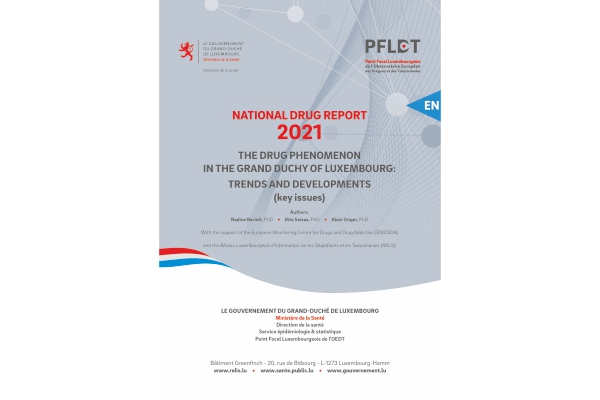 Credit: RELIS
Credit: RELIS
The RELIS National Drug Report 2021 has confirmed an increase in the proportion of cocaine users amongst a general reduction in the consumption of opiates among high-risk users in Luxembourg.
The RELIS 2021 report, published by Luxembourg's Ministry of Health, aims to provide an overview of the drug phenomenon in the Grand Duchy, particularly regarding the use of illicit drugs and its consequences at the national level.
National illicit drug use
In terms of drug use among the general population, the most recent data (2018) shows that cannabis is the most widely used controlled drug at the national level, followed by substances in the stimulant class. Compared to the situation in 2014, the prevalence of use during life, the last twelve months and the last 30 days of cannabis and controlled stimulants show slight increases, though not significant. As a comparative indicator, recent use of cannabis and stimulants among young adults (15-34 years) is below the respective average rate in the European Union (EU). In case of fifteen to eighteen year olds, a moderate increase in last month cannabis use was observed between 2006 and 2018. However, this increase is statistically significant only among girls. The data on adolescents in Luxembourg is largely similar to the average of all the countries that took part in the international health behaviour in school-aged children (HBSC) survey. Heroin use remains marginal within the general population, all ages combined.
With reference to the high-risk use of drugs of illicit origin, a downward trend was observed in the Grand Duchy of Luxembourg between 2003 and 2018, followed by a first stabilisation plateau in 2019/2020. Based on data updated since the previous annual report, it is estimated that the number of people with this type of use in Luxembourg is around 2,160, which is equivalent to a prevalence rate of 5.06 users per 1,000 inhabitants of age between 15 and 64. In 2000, this same rate was equivalent to 9.0 users per 1,000 inhabitants and was then among the highest in the EU. A decrease in the prevalence of opiate use and a stabilisation of injection use is also observed.
Gradual evolution towards lower risk modes of administration
Opioids, heroin in particular, remain the most common drugs amongst the high-risk drug users. However, the use of first-choice opioids is trending downwards, while the use of cocaine and cocaine-containing mixes/cocktails is increasing. Polydrug addiction, although showing a certain stability in recent years, remains predominant within this same population.
Among users attending supervised drug consumption rooms nationwide, inhalant use is still gaining ground over injection use. Thanks to common harm reduction efforts, between 52% and 69% of users of the various supervised drug consumption rooms and 59.7% (2013: 37.4%) of high-risk drug users in general are meanwhile inhalation drug users, which constitutes a mode of consumption with less risk, thus contributing in particular to a reduction in the risk of overdoses and the transmission of certain infectious diseases.
Morbidity and mortality associated with drug use
Between 2014 and 2016, there was a significant national increase in new HIV infections among people who inject drugs (21 cases in 2016), attributable in part to the increased availability and use of cocaine by injection. In past four years a marked decline is observed in the number of people who inject drugs among new HIV infections. In 2020, there were four new cases of HIV infection among IDUs, compared to five cases in 2018 and three cases in 2019. The average age of fatal overdose victims continues to show an upward trend (41.5 years)
Although HCV (hepatitis C) infections among drug injectors appear to be declining recently, serological and self-reported prevalence rates (44.4% – 60.5%) remain high among the same users.
Since the deployment of national action plans on drugs and related addictions, an overall downward trend in overdose deaths has been observed at national level. In 2000, 26 victims of a fatal overdose were observed compared to six victims in 2020.
Demand for treatment and harm reduction offers in a pandemic context
The number of drug users in treatment, which followed a general upward trend, as well as the number of contacts with national aid and harm reduction structures, showed a drop in 2020. The latter reached 146,000 episodes of contacts (in 2019: 164,000 and in 2016: 150,937) and the number of contacts in treatment (multiple counts included) was 2,715 (number comparable to that of 2014). In 2020, a drop in the number of sterile syringes distributed as part of the national syringe exchange programme was observed (2013: 190,257; 2019: 425,906; 2020: 393,692 sterile syringes distributed). These changes are noted in light of the constraints and restrictions related to the management of the COVID-19 health crisis.
The average age of drug users in treatment has generally increased over the past 20 years (36.8 years in 2020 compared to 28 years in 1997). Treatment seekers are mostly men (78.6%). The number of opioid users entering treatment has declined over the past ten years (49% in 2020 and 88% in 2010) while the number of people in treatment for cannabis use and for cocaine use has experienced a discontinuous upward trend over the same period. Since 2013, there has been a stabilisation in the number of applicants for substitution treatment for opioid users.
Illicit drug deals: increase in the amount of cannabis and cocaine seized
Overall, cannabis seizures represented 67% of the total number of seizures in Luxembourg in 2020. The number and quantity of cannabis seized peaked in 2019 (371 kg out of a total of 1,315 seizures). In terms of the number of cocaine and heroin seizures, current trends are less apparent. Since 2014, the purity of cocaine on the market has tended to increase, while 2019 and 2020 show an initial stagnation. As for cannabis, its average THC concentration has increased from around 9% in 2012 to 14.5% in 2020.
The RELIS 2021 summary is available online via the Health portal: www.sante.lu.








